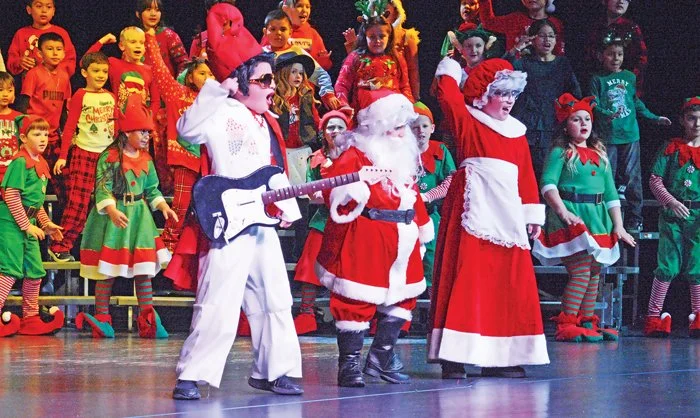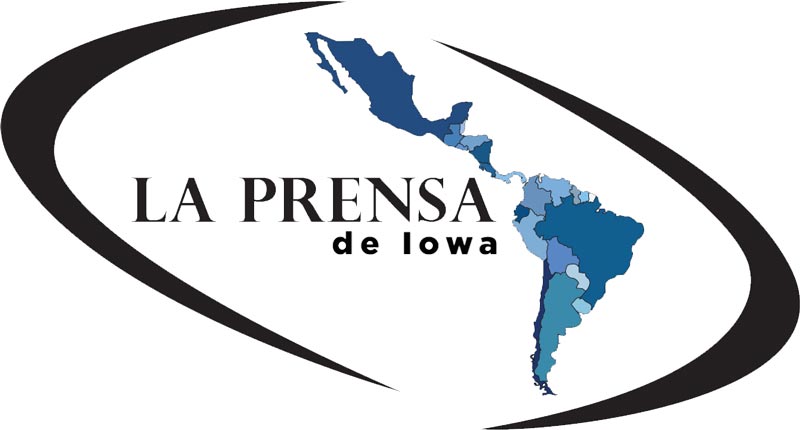Trazando la historia Latina en la comunidad
/⇣ English translation provided at the end ⇣
Estudiantes aprenden sobre comunidad Latina en Iowa central
(Derecha a izquierda) Katie Murphy, Lupita Deanda Valdez y Jake Vakulskas escogieron al propietario del restaurante El Paisano V, en Denison, Marco Amezcua para su proyecto. Foto cortesía de Stacy Alex.
Ashley Martínez Torres
Especial para LA PRENSA Iowa
Un grupo de estudiantes del colegio comunitario Morningside de Siux City viajaron a través de 23 sitios en Iowa para conocer a lideres y emprendedores de la comunidad Latina y aprender sobre sus historias de cómo llegaron a estos lugares y los obstáculos por los que pasaron. La profesora de español Stacy Alex estuvo a cargo del proyecto de los estudiantes, en el cual una de sus metas era entender la diversidad que existe entre las comunidades latinas. “Quería que mis estudiantes pensaran sobre como las comunidades latinas eran tanto visibles como invisibles a través de las historias contadas por gente Latina y no Latina,” explicó.
La estudiante de segundo año Lupita Deanda Valdez comentó, “Fue interesante ver como variaban las comunidades latinas en cada lugar que visitamos.”
Por su parte, estudiante de último año en la universidad Morningside Katie Murphy explicó que fue sorprendente ver el número de comunidades que se encuentran en Iowa debido a que ella es originaria de Dakota del Sur y “no se ve el nivel de diversidad que hay en Denison”
Otros enforques de la clase incluyeron el entender la historia de la presencia latina en los Estados Unidos y las razones por las que los inmigrantes deciden inmigrar a algunas ciudades de Iowa, discutir el concepto erróneo de que la inmigración es un tema reciente, discutir los obstáculos a los que siguen enfrentándose las comunidades y aportar posibles soluciones.
“Al aprender sobre la historia personal de un latino, los estudiantes se dan cuenta de que tienen más cosas en común de lo que piensan, como el querer apoyar a nuestras familias y los obstáculos que enfrentamos.” Explico Stacy. “Pero también aprenden como algunas personas tienen más obstáculos que otros.”
Lupita compartió que al hablar con dueños de negocios latinos sintió que se creo una conexión de apoyo entre ellos. “Cada persona tiene su propia historia y mientras más preguntas les haces, más cómodos se sienten hablando contigo, “explicó. “Una de las personas con las que hablé me dio consejos de vida, eso me hizo sentir como si estuviera hablando con mi abuelo o un tío.”
De igual manera, Katie comentó que tuvo la oportunidad de no solo practicar el español, pero también de conectarse con la comunidad latina y sentirse bienvenida a los establecimientos latinos ya que “antes me sentía fuera de lugar cada vez que entraba en una tienda latina.”
“Todos deberían tomar una clase acerca de otra cultura porque ayuda mucho en ser más educado sobre la diversidad que hay en tu comunidad y tener una nueva perspectiva,” comentó Katie.
Estudiantes de Morningside College de visita en las oficinas de LA PRENSA Iowa para hablar con nuestra editora Lorena López sobre su experiencia como periodista. Ashley Martínez/Especial para LA PRENSA Iowa.
Además de conocer sobre la cultura latina que existe en varios lugares de Iowa y hacer conexiones con emprendedores y lideres de dicha comunidad, Stacy dijo que los estudiantes también aprendieron sobre el bilingüismo y la importancia de preservar el idioma español, “Hace unas generaciones atrás, los niños eran castigados por hablar sus idiomas nativos en las escuelas, y los estudiantes aprendieron que este es un tema mas complicado de lo que pensaban, pero uno que merece más atención.”
Debido a que el curso es intensivo de tres semanas, las entrevistas hechas por los estudiantes no son hechas de manera formal, sin embargo, Stacey comentó que “me gustaría hacer entrevistas más largas y subir grabaciones a mi sitio web” para que las historias estén disponibles para el público. Además, agregó que le gusta la idea de expandir su colección actual para incluir latinos que viven en las afueras de Iowa.
Stacy se especializa en estudios Latino y enseña una variedad de cursos que exploran el lenguaje y cultura latina en las comunidades de los Estados Unidos. Ella también creo el proyecto en línea Latinx Stories of Siouxland, un archivo que contiene historias orales de gente latina, y es coautora de Mi Idioma, mi comunidad: español para bilingües, un libro de libre exceso que trata sobre la experiencia de estudiantes con el lenguaje, la identidad y vivir en el Medio Oeste.
Este artículo es patrocinado gracias a Western Iowa Journalism Foundation.
Estudiantes de Morningside College se embarcaron en un viaje a través varias ciudades en Iowa central para aprender más sobre lideres Latinos en la comunidad. Una de sus paradas incluyó una visita a la biblioteca de Sioux Center en donde Ruth Mahaffy (izquierda) y Evelyn León (derecha) hablaron sobre el programa bilingüe que la biblioteca ofrece. Ashley Martínez/Especial para LA PRENSA Iowa.
Translation
Tracing Latino History in the Community
(From right to left) Katie Murphy, Lupita Deanda Valdez y Jake Vakulskas chose to meet El Paisano V Owner Marco Amezcua as part of their project. Photo courtesy of Stacy Alex.
Ashley Martínez Torres
Special for LA PRENSA Iowa
A group of college students traveled throughout 23 places in Central Iowa to meet leaders and entrepreneurs from the Latino community and learn about their stories of how they got to settle in these places and the obstacles they went through.
Spanish Professor Assistance Stacy Alex was in charge of this trip, in which one of her goals was to understand the diversity of and within Latino communities. "I wanted my students to think about how Latino communities were both visible and invisible through stories told by Latino and non-Latino people," she explained.
Sophomore at Morningside Lupita Deanda Valdez said, "It was interesting to see how Latino communities varied in each place we visited."
Morningside College Senior Katie Murphy said it was surprising to see the number of communities in Iowa because she's originally from South Dakota and "you don't see the same level of diversity that is here."
The class also focused on understanding the history of the Latino presence in the United States and the reasons immigrants decided to move here, discussing the misconception that immigration is a recent issue, discussing the obstacles the community continues to face and providing possible solutions.
"By learning about a Latino personal history, students realize they have more in common than they think, such as wanting to support our families and the obstacles we face." Alex explained. "But they also learn how some people have more obstacles than others."
As a proof of this, Deanda Valdez shared that when talking to Latino business owners she created a supportive relationship with them. "Each person has their own story and the more questions you ask them, the more comfortable they feel talking to you," she explained. "One of the people I talked to gave me life advice, that made me feel like I was talking to my grandfather or an uncle."
Morningside College students paid a visit to LA PRENSA Iowa office to interview Editor Lorena Lopez about her career and journey. Ashley Martínez/Special for LA PRENSA Iowa.
Likewise, Katie said that she had the opportunity to not only practice her Spanish, but also to connect with the Latino community and feel welcome to Latino establishments since "I used to feel out of place every time I walked into a Latino store."
"Everyone should take a class about another culture because it helps a lot in being more educated about the diversity in your community and having a new perspective," Murphy advised.
In addition to learning about the Latino culture that exists in various parts of Iowa and making connections with entrepreneurs and leaders of that community, the students also learned about bilingualism and the importance of preserving the language, because Spanish is often lost between Latino generations.
"A few generations ago, children were punished for speaking their native languages in schools, and students learned that this is a more complicated issue than they thought, but one that deserves more attention," Alex added.
Because this is a three-week intensive course, interviews done by students are not done formally, however, Alex said that "I would like to do longer interviews and upload recordings to my website" to make the stories available to the public. She also added that she likes the idea of expanding her current stories collection to include Latinos living just outside of Iowa.
Alex specializes in Latino studies and teaches a variety of courses that explore Latino language and culture in U.S. communities. She also created the online project Latinx Stories of Siouxland, an archive containing oral histories of Latino people, and is co-author of Mi Idioma, mi comunidad: español para bilingües, a book of free excess that deals with students' experience with language, identity and living in the Midwest.
This article is sponsored by the Western Iowa Journalism Foundation.
Morningside College students embarked on a journey through several towns in Central Iowa to learn more about Latino leaders in the community. One of their stops included a visit to the Sioux Center library where Ruth Mahaffy (left) and Evelyn Leon (right) talked about the bilingual program the library offers. Ashley Martínez/Special for LA PRENSA Iowa.












































